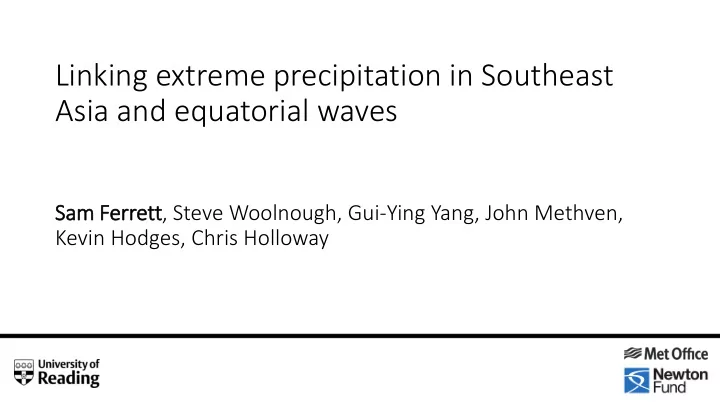

Linking extreme precipitation in Southeast Asia and equatorial waves Sa Sam Ferrett, Steve Woolnough, Gui-Ying Yang, John Methven, Kevin Hodges, Chris Holloway
Equatorial Waves Figure from Yang et al. (2003) Kelvin wave (110E-115E,0) • Wave datasets, ERA-Interim and TRMM precipitation (1997- ‘positive’ 2016) are used to examine statistical relationship between high amplitude waves and mean and extreme precipitation in SE Asia • Wave activity is found by averaging low-level convergence/divergence (or vorticity for R1) over longitude ranges in the region and a single latitude, depending on ‘negative’ wave structure. • ‘high amplitude’ >95 th percentile/<5 th percentile
Wave activity over SE Asia Hovmollers of composite precipitation anomaly (TRMM) and wave convergence (wave datasets) prior and following a high amplitude wave over longitude 100E-105E - - Increased mean precipitation Increased mean precipitation coincident with wave coincident with wave convergence/positive vorticity convergence/positive vorticity - - Changes in precipitation Changes in precipitation associated with R1 waves much associated with R1 waves much stronger in JJA stronger in JJA Ferrett et al. (submitted) Linking Extreme Precipitation in Southeast Asia to Equatorial Waves.
Mean precipitation changes: Kelvin Ferrett et al. (submitted) Linking Extreme Precipitation in Southeast Asia to Equatorial Waves.
Extreme precipitation likelihood - Examine likelihood of rainfall exceeding extreme rainfall threshold (95 th percentile of 1998-2016 rainfall) - 5% indicates no change from climatology - Waves can be linked to increases in likelihood of extreme rainfall by 2-3 times Ferrett et al. (submitted) Linking Extreme Precipitation in Southeast Asia to Equatorial Waves.
Wave phases: Kelvin - For more detailed statistical analysis we expand on divergence metric by creating localised wave phases based on standardised convergence and zonal wind - As waves propagate eastward moves through phases - Distance from origin indicates amplitude of wave Kelvin wave phases (by divergence & zonal wind), filled contours show 850 hPa divergence
Wave phases: R1 - For R1 and WMRG waves use zonal and meridional winds - As waves propogate westward moves through phases N=1 Rossby wave phases (by equ. zonal & NH meridional wind), filled contours show 850 hPa vorticity
Wave phases: WMRG WMRG wave phases (by NH zonal & equ. meridional wind), filled contours show 850 hPa vorticity
Extreme precipitation likelihood by wave phase: Malaysia • Wave convergence linked to increased likelihood of extreme rainfall in PM • WMRG and Kelvin waves linked to more frequent heavy rainfall in EM
Extreme precipitation likelihood by wave phase: Indonesia • Kelvin waves linked to increased likelihood of extreme rainfall in all areas of Indonesia (JJA) • WMRG wave linked to increased occurrence of extreme rainfall in Java
Extreme precipitation likelihood by wave phase: Philippines • Large increases in likelihood of extreme precipitation in Philippines associated with R1 and WMRG waves • A result of tropical cyclones in JJA.
Waves-precip relationship in UKMO global forecast - Recently a method of identifying waves in ‘real - time’ has been developed. - Future work will involve examination of the statistical relationship between waves and precipitation in UKMO forecasts. - Initial results suggest weakening of observed wave-precip relationship with lead time.
Summary • High amplitude wave activity linked to increased mean and extreme precipitation in regions of SE Asia, including Malaysia, Indonesia and the Philippines • Likelihood of extreme precipitation increases, and can be up to three times more likely, during high amplitude waves. • Work has begun on assessing statistical relationship in global and regional UKMO forecasts
Regional precipitation changes • All three waves linked to increased DJF precipitation in Malaysia • WMRG has the strongest influence, in Peninsular Malaysia.
• Kelvin wave most influence Indonesia region rainfall, Sumatra when over 100- 105E, Kalimantan and Java when over 110-115E, Sulawesi when over 120-120E • Java rainfall also linked to negative phase of WMRG wave
Regional precipitation changes • Tropical cyclones account for a portion of increased DJF rainfall during R1 and WMRG waves • South Philippines rainfall may still be influenced by waves alone
Recommend
More recommend